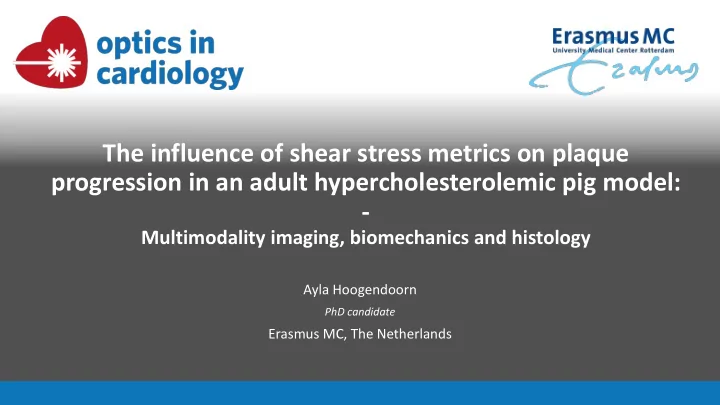

The influence of shear stress metrics on plaque progression in an adult hypercholesterolemic pig model: - Multimodality imaging, biomechanics and histology Ayla Hoogendoorn PhD candidate Erasmus MC, The Netherlands
Biomechanics in atherosclerosis ? Shear stress
Wall shear stress Plaque Plaque initiation progression ? Low shear stress ? Endothelial dysfunction Shear stress metrics: Time-averaged wall shear stress, oscillatory shear index, relative residence time, Plaque formation transWSS and cross-flow index
The porcine study: timeline
Observed plaque size (IVUS) Range plaque burden (%): 0-80% * p<0.05 compared to T1 # p<0.05 compared to fast responder
Histology: plaque types (n=20 arteries) Lipids (red) Lipids (red)
Histology: plaque components Collagen staining Endothelial cells (brown) N=5 Lipids (red) H&E staining
From imaging to wall shear stress Wall shear stress Flow 1 Pa CFD Flow 2 Flow 3 Flow 4 Flow 5
Shear stress metrics • Time-averaged wall shear stress (TAWSS) Low Pro-atherogenic • Oscillatory shear index (OSI) High • Cross-flow index (CFI) OSI ≈ • Transverse wall shear stress (transWSS) • Relative residence time (RRT)
Plaque growth vs. baseline shear stress metrics
Relationship between lipid-rich plaque and shear stress NIRS 2D map at T3 Circumferential direction Longitudinal direction
Conclusion • We presented: • An adult, hypercholesterolemic pig model • Plaque development imaged at 3 time point over 1 year • Detailed, individually tailored, shear stress analysis • The pig model showed: • Large plaques with unstable features and, uniquely, 5 cases of old ruptures • Difference between fast and slow responders • All 5 shear stress metrics showed a significant relationship with plaque growth in the fast responding animals
Acknowledgements Erasmus MC, biomedical engineering Annette Kok Erasmus MC, radiology Eline Hartman Marcel Dijkshoorn Kim van Gaalen Adriaan Coenen Kim van der Heiden Koen Nieman Frank Gijsen Ton van der Steen Jolanda Wentzel Erasmus MC, animal facilities Vincent Vaes Erasmus MC, experimental cardiology Dennis Akkermans Ilona Peters Maaike Visser – te Lintel Hekkert Dirk-Jan Duncker AMC, biomedical engineering, Amsterdam Lorena Casadonte Erasmus MC, interventional cardiology Maria Siebes Karen Witberg Jurgen Ligthart
Slow and fast responders
Histology: plaque components CD68 (macrophages) Collagen
Influence of PA on PA growth
TAWSS/OSI TAWSS/CFI
Predictive value for plaque at T3 Fast responders Positive predictive value Sensitivity TAWSS (low) 49.4% 43.1% OSI (high) 48.0% 40.3% RRT (high) 49.3% 42.5% CFI (high) 47.0% 40.6% transWSS (high) 42.7% 36.8% * Plaque = Wall Thickness >0.5mm
Predictive value for plaque* at T3 Fast Slow responders responders Positive predictive value Sensitivity Positive predictive value Sensitivity TAWSS (low) 88.5% 36.9% TAWSS (low) 64.3% 45.0% OSI (high) 88.9% 35.6% OSI (high) 58.7% 40.9% RRT (high) 88.2% 36.4% RRT (high) 64.1% 44.6% CFI (high) 86.8% 35.8% CFI (high) 56.3% 39.2% transWSS (high) 84.5% 34.8% transWSS (high) 48.7% 33.9% • * Plaque = Wall Thickness >0.2mm
TransWSS Transverse WSS
Near-infrared spectroscopy vs. TAWSS
Porcine models of atherosclerosis: the main challenges • Many interventions needed to get plaque development • (High-fat diet, diabetes, hypertension, etc.) • Unstable plaques/plaque rupture is rare • Only young, growing animals are used • Less comparable to human situation • Influence of vascular growth on changes in shear stress cannot be ruled out
Recommend
More recommend